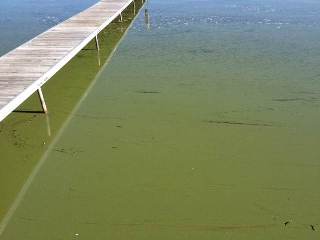An Analysis of the Nuisance Cyanobacterium Gloeotrichia in Silver Lake, Michigan
Algal blooms have been observed over the past two years in Silver Lake (Oceana County, MI), often forming dense surface scums. The nuisance cyanobacterium (blue-green alga) Gloeotrichia has been identified as the dominant bloom forming genus in the lake. Gloeotrichia over-winters in lakes as akinetes (spores) that can attach to sediments. As temperatures warm in spring, the akinetes germinate and form colonies that detach from the sediments and float to the surface. These colonies appear near the lake surface as tiny green globs. Wind and water currents can cause the Gloeotrichia colonies to become concentrated on downwind shores (as shown to the right), only to become dispersed throughout the lake again when the wind shifts.
Not only do Gloeotrichia blooms cloud the water, they also may pose a human health and ecological concern. Gloeotrichia is capable of forming cyanotoxins, specifically the hepatotoxin microcystin.

Algal surface scum in Silver Lake in June 2012. Gloeotrichia was the dominant genus present in the bloom. (Photo courtesy of the Silver Lake Improvement Board)
[1406813400].jpg)
3 Gloeotrichia colonies under microscope magnification.
Our study has 3 major components, which will produce the information needed to better understand the dynamics and potential consequences of Gloeotrichia blooms in Silver Lake.
- Bimonthly monitoring of the algal community in Silver Lake (April-October, 2014) to identify seasonal changes in algal community composition
- Microcystin analysis on each bimonthly algal sample to evaluate cyanotoxin production
- Nutrient bioassays to identify the nutrient(s) limiting algal growth in Silver Lake. The effect of nutrients on algal community structure, chlorophyll a, and microcystin production will also be analyzed.
This study complements the Silver Lake nutrient budget study being conducted by USGS and AWRI, funded by the Silver Lake Improvement Board. The results of our Gloeotrichia study will be integrated into the larger nutrient budget project, and help inform the final management decisions to be implemented to improve water quality in Silver Lake.
Funding for this project was provided by the Michigan Department of Environmental Quality, as part of the Clean Michigan Initiative.
Contacts:
Al Steinman, AWRI Project Manager: [email protected]
Mary Ogdahl, Lead Technician: [email protected]

